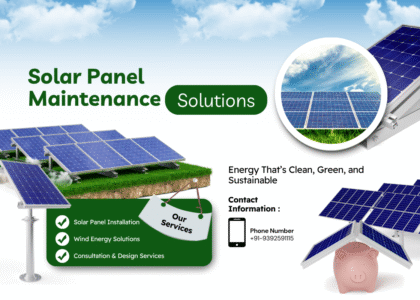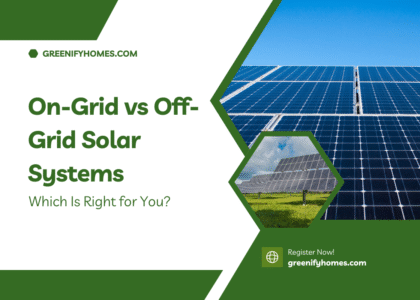Introduction
Tired of seeing your electricity bills go up every year? You’re not alone. With rising energy tariffs across India, more and more homeowners are turning to solar power — and not just for the environment, but for their wallets too.
Wondering if solar panels can really cut your bill down to size? Let’s break it down in simple terms.
How Solar Panels Work
Solar panels absorb sunlight and convert it into direct current (DC) electricity. An inverter then converts that into alternating current (AC) — which powers your appliances.
In an on-grid system, excess power is sent back to the electricity grid. When your panels aren’t producing enough (like at night), you pull energy from the grid — creating a balance.
Understanding Your Electricity Bill
Let’s say you use 400 units (kWh) per month. If your DISCOM charges ₹7 per unit:
400 units × ₹7 = ₹2,800/month
That’s ₹33,600 per year!
Now imagine cutting that down by 80–100%… that’s where solar comes in.
Where the Savings Come From
✅ Lower Grid Dependency:
Your solar system generates electricity during the day, reducing how much you draw from the grid.
✅ Net Metering:
Sell excess energy back to the grid and earn credits, which offset your night-time usage.
✅ Protection Against Price Hikes:
Electricity rates increase every year, but solar shields you from those hikes for 25+ years.
Real-Life Savings Example
📌 Example: 3BHK Home in Delhi
- Average Monthly Bill (Before Solar): ₹3,000
- System Installed: 4 kW On-Grid
- Solar Generation: ~500 units/month
- New Monthly Bill: ₹200 – ₹300 (just grid charges)
- Annual Savings: ₹30,000+
- Payback Time: 4–5 years
- Lifetime Savings: ₹12–15 Lakhs over 25 years
Net Metering – The Secret Weapon
With net metering, your solar system exports unused electricity to the grid during the day. At night, when you use grid power, you’re billed only for the net consumption.
So if you export 300 units and consume 350, you only pay for 50!
It’s like having your own mini power station that earns you credits.
Cost of Solar Panel Installation
| System Size | Cost (Before Subsidy) | Cost (After Subsidy*) |
|---|---|---|
| 3 kW | ₹1.6 – ₹2.2 Lakhs | ₹1 – ₹1.3 Lakhs |
| 5 kW | ₹2.5 – ₹3.5 Lakhs | ₹1.6 – ₹2.2 Lakhs |
*Government offers up to 40% subsidy on residential solar in 2025
Break-Even Point and Payback Period
A well-installed solar system usually pays for itself in 4–6 years. After that, the electricity is practically free for the next 20+ years.
And remember: every ₹ saved is ₹ earned, tax-free!
Additional Benefits Beyond Bill Savings
💹 Increase Home Value: Solar-ready homes attract modern buyers
🌱 Eco-Friendly: Reduce your carbon footprint
⚡ Energy Independence: Less reliance on the grid = peace of mind
Is Solar Right for Every Home?
Solar works best if:
- You own your home and have a south-facing roof
- You use more than 300 units/month
- Your roof is shadow-free for most of the day
- Your local DISCOM supports net metering
Conclusion
Solar panels don’t just help the planet — they help your pocket too. If you’re tired of rising bills, a one-time investment in solar can lead to lifelong savings, higher property value, and more control over your energy use.
With subsidies, net metering, and cleaner energy on your side, there’s no better time to go solar than now.
FAQs
1. How much can I save with solar every year?
A. Depending on your usage, you can save ₹20,000 to ₹60,000 annually on electricity.
2. Do I still get electricity during power cuts?
A. Only if you have a battery backup or hybrid system. On-grid systems shut off during outages.
3. What happens on cloudy days?
A. Solar panels still generate power, just at reduced efficiency. You can draw the rest from the grid.
4. Will I get a 0 electricity bill?
A. You may still pay a small fixed charge (~₹100–300/month) for the grid connection.
5. Is EMI or loan available for solar systems?
A. Yes! Many banks and NBFCs offer solar loans with low interest and 3–7 year tenure.









